
#TenTwoFourBreak
Claude Monet, The Thames at Charing Cross Bridge, London, (Detail), 1899. Oil on canvas, 25 x 35 3/8 in. Collection of Shelburne Museum, gift of the Electra Havemeyer Webb Fund, Inc. 1972-69.3.
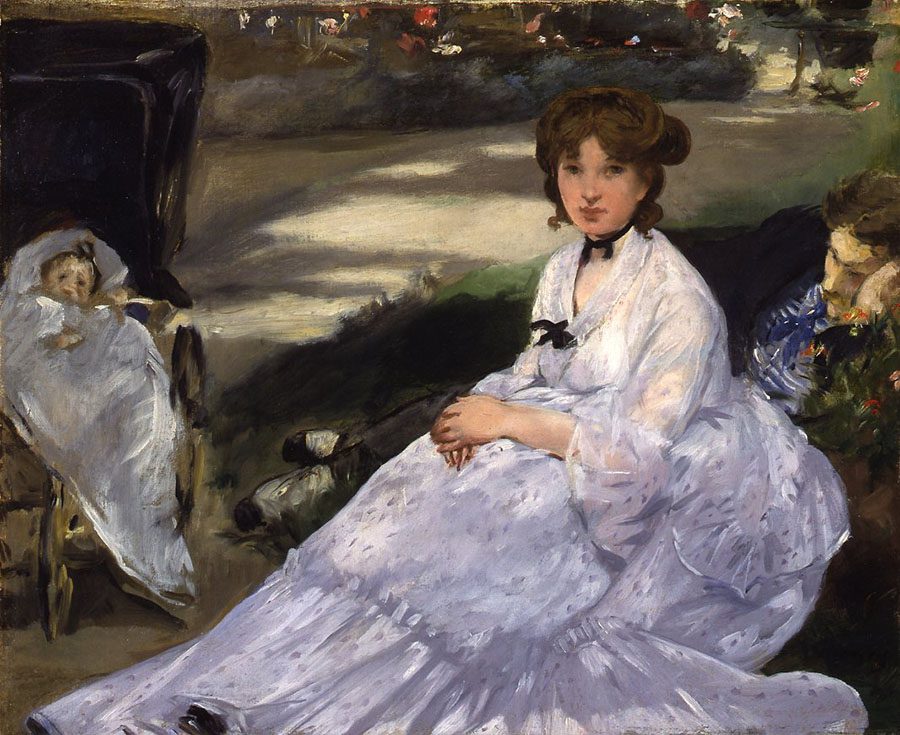
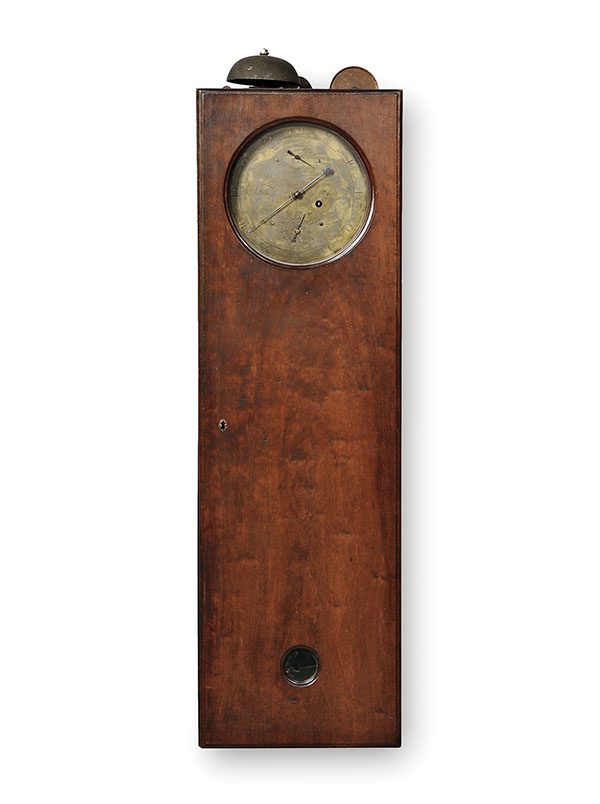
“Regulator clocks” were invented in circa 1720 England in the quest for greater timekeeping precision. These devices were powered by a weighted and geared mechanism, and could be accurate to within 10 seconds per month—unlike typical clocks of the day, which were only accurate to within about 5 minutes per week. Regulators were initially used in observatories and clock and watch shops as the standard of accuracy during repairs, synchronization, and manufacturing. This regulator was built by Levi Pitkin, a craftsman who was listed as a jeweler, silversmith, and clockmaker in Montpelier, Vermont by 1796. Pitkin had previously apprenticed to Connecticut clockmaker Daniel Burnap, and this device is related to a movement sketch in Burnap’s Memorandum book, now at the Connecticut Historical Society.
Throughout history, there have been many ways to tell time. This regulator clock uses weights to swing a pendulum to keep time throughout the day. We are going to try telling time naturally today! Go out 3 times today and estimate what time you think it is!
10 am: Use the Sun to tell the time! Start by standing with your toes facing the Sun. Then extend your arm toward the horizon. Count the number of hands you can fit between the horizon and the Sun. The number will tell you it’s 10 am!
2 pm: Use your shadow to tell the time! Our shadows are longest at the very beginning of the day and at the very end of the day. Our shadows are the shortest at noon right in the middle of the day. How long is your shadow at 2 pm?
4 pm: Challenge your friends to put down their smart phones and try out telling time naturally with you today!

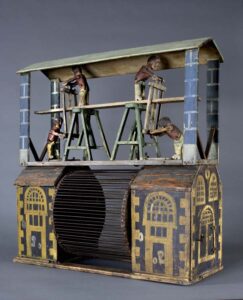
Squirrels were among the most popular types of wildlife kept as pets in America throughout the 1800s and early 1900s. Special cages equipped with exercise wheels were designed specifically to house these difficult-to-tame rodents. This elaborate cage with movable, articulated, sawing figures attached to the tin turbine was probably made as a child’s toy to entertain both the captive squirrel and its young human caretaker.

This red and white album quilt was made by Kathleen Merrifield Landry and includes the names of both the Merrifield and Landry families, as well as parishioners in Canajoharie, New York. While the quilt was made in the year of a major influenza pandemic, it is meant to be a tribute to those who died (marked with a gold star) and those who served (a blue star) in World War I. Landry worked for the Veterans Administration and was posted to various army bases as a nutritionist during the War. Her obituary described her as one of the first women to join the armed forces.
Quilting is a great way to combine different ideas into one piece of artwork or fabric. Each person has different thoughts and creativity. If you could make one square on a quilt, what would it look like?
10 am: Start drafting your design. What would you want to include on the square?
2 pm: Have a critique! Share your drafts with those around you.
4 pm: Cut a square out of a regular piece of paper. Draw your favorite design on your square.
We would love to see all the quilt pieces! Share your picture on Facebook, Instagram and Twitter!
Use the #’s #MuseumfromHome #ShelburneMuseumFromHome #ShelburneMuseum #TenTwoFourBreak #TenTwoFourBreakChallenge
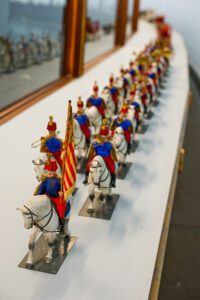
This band of British Horse Grenadier Guards is one of five musical ensembles featured in Roy Arnold’s miniature circus parade on permanent view in Shelburne Museum’s Circus Building. Arnold, an executive at the Strathmore Paper Company by day, spent every night, weekend, and holiday for twenty-five years carving the 5 bands, 83 musicians, 53 wagons, 400 horses, 90 ponies, mules, and donkeys, 30 elephants, 33 camels, 14 zebras, 80 caged animals, 60 lead animals, 20 clowns, 170 riders, and over 130 different personnel in this winding, wooden wonder. Painstakingly executed on a one-inch to one-foot scale, the approximately 525-foot long Arnold Circus Parade model would stretch more than two miles in length if life-sized.
Parades are great ways to bring people together to celebrate! In our opinion, the best part of a parade is music! Did you know that you can still make music without an instrument? Try these fun activities today and see what kinds of sounds you can make with just your body!
10 am: Clap your hands to the beat of your favorite song! Can you change the volume by making the claps quieter and louder?
2 pm: Snap your fingers to the beat of your favorite short tune! If you don’t know how to snap, try tapping your fingers on a hard surface and see what that sounds like!
4 pm: Stomp your feet to the beat of your favorite song! Did it sound different than the clapping and snapping? Can you change the speed of the sounds by stomping slower or faster?
What song did you choose to try out the activities with? Comment on Facebook, Instagram and Twitter!
Use the #’s #MuseumfromHome #ShelburneMuseumFromHome #ShelburneMuseum #TenTwoFourBreak #TenTwoFourBreakChallenge

With The Pemigewasset Coach, artist Enoch Wood Perry encouraged viewers to conjure and celebrate a way of American life that had all but disappeared by the close of the 19th century. The painting’s title derived from the name of the horse-drawn stagecoach that carried New Hampshire summer travelers between Concord and the Pemigewasset House in Plymouth. By the 1890s, most travelers would have journeyed by train, and coaches like this one were an anachronistic nod to a simpler, less industrialized past. Populations in small communities like Concord and Plymouth were rapidly dwindling as young people relocated to urban centers in search of factory jobs. Paintings like this one appealed to consumers in large cities who yearned for the past, whether real or imagined.
People used to travel in coaches before we had trains or cars. Now, we get around to places in many ways. Let’s try to move around using 3 different actions today!
10 am: Crab Walk from one place to the other. See how far you can go!
2 pm: Bear Crawl from one place to the other. See how far you can go!
4 pm: Frog Jump from one place to the other. See how far you can go!
Tag a friend you’d like to see do these moves on Facebook, Instagram and Twitter!
Use the #’s #MuseumfromHome #ShelburneMuseumFromHome #ShelburneMuseum #TenTwoFourBreak #TenTwoFourBreakChallenge
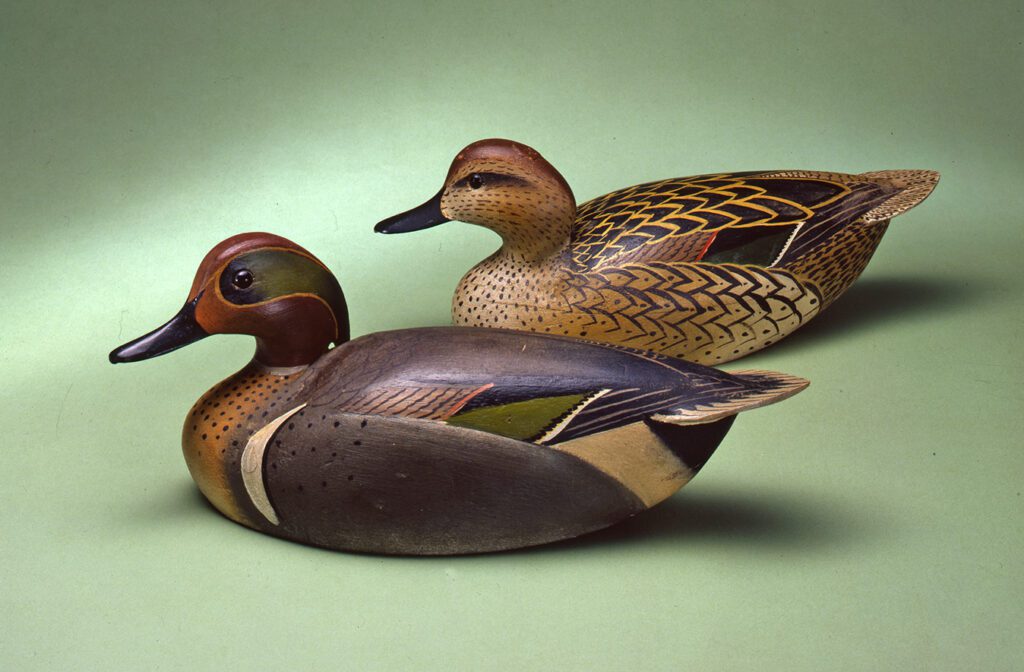
This green-winged teal drake (male) and hen (female) were carved and painted by Lemuel “Lem” Ward of Crisfield, Maryland, who, along with his twin-brother Steve, helped elevate the craft of decoy carving to an acknowledged art form with their lifelike working and decorative birds. While Steve was renowned for his superb carving skills, Lem was highly regarded for his talent as a painter of bird plumage, a practice he called “pulling feathers.”
Doing things with a buddy is always more fun than doing things by yourself. That’s why so many objects go together in pairs! Today we are going to go on a hunt in 3 different locations to see how many pairs we can find.
10 am: What items can you find in your bedroom that come in pairs?
2 pm: Go outside and see if you can find things that come in pairs in nature!
4 pm: Can you find paired items in your kitchen?
Share your favorite pair that you saw today on Facebook, Instagram and Twitter, and tag a friend you want to challenge!
Use the #’s #MuseumfromHome #ShelburneMuseumFromHome #ShelburneMuseum #TenTwoFourBreak #TenTwoFourBreakChallenge
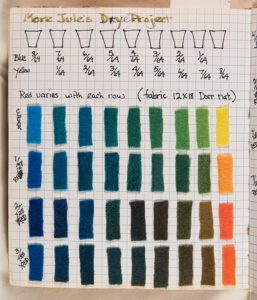
Like an artist’s palette, this object offers a glimpse into the experimentation that went hand-in-hand with American rug hooker Patty Yoder’s (1943-2005) practice. Beginning in 1992, Patty recorded her dye experiments in this color book, with several pages referencing precise dye calibrations for many of the beloved rugs included in her Alphabet of Sheep series.
Colors come in all kinds of shades and hues. We can find many colors in our crayon and marker container, but they also exist out in our homes and in nature as well! Today we are going on a hunt to find as many different colors as we can! While hunting, please bring paper and coloring utensils to record the colors you find.
10 am: Look around your home. Write/draw the different colors you see. How many did you find?
2 pm: Go outside in your yard or right outside your home. Can you find more colors? Write/draw the different colors you see.
4 pm: Take a short walk. How many different shades of green can you find? Write/draw the different colors you see.
Share the number of colors you found throughout the day on Facebook, Instagram and Twitter, and tag a friend you want to challenge!
Use the #’s #MuseumfromHome #ShelburneMuseumFromHome #ShelburneMuseum #TenTwoFourBreak #TenTwoFourBreakChallenge

This circus poster featuring a group or “tower” of giraffes was discovered in 1991 hidden beneath the exterior siding on a home in Colchester, Vermont. It was originally pasted to the home’s façade by Adam Forepaugh’s (pronounced “four paw”) circus 108 years prior in the summer of 1883 several weeks before the show was scheduled to perform in nearby Burlington.
Did you know giraffes are the tallest land mammal in the world? That’s impressive! Let’s try some lengthening stretches to see if we can improve our posture or even grow a little bit taller today!
10 am: Flat as a Board: Find a flat spot on the wall and stand up against it. Try to keep your lower back on the wall the whole time and stretch your arms above your head. Then reach as high as you can and hold the pose for at least 30 seconds!
2 pm: Downward Dog: Put your feet hip-width apart and hands in front, shoot your hips up and back until your legs are straight. Try to hold the pose for at least 30 seconds!
4 pm: Hip Flexor: Lunge with your right leg first. Then sink down toward the ground with your hips until your left knee touches the ground. You should feel a stretch in your left hip. Try to hold the stretch for at least 30 seconds, then switch legs!
Which pose was your favorite? Did anyone feel like they grew taller?
Share how it went or post pictures on Facebook, Instagram and Twitter, and tag a friend you want to challenge!
Use the #’s #MuseumfromHome #ShelburneMuseumFromHome #ShelburneMuseum #TenTwoFourBreak #TenTwoFourBreakChallenge
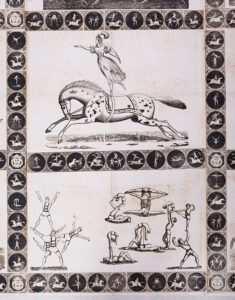
These two black and white scenes come from one of the largest and oldest circus posters in Shelburne Museum’s collection. Measuring 10 feet tall and nearly 7 feet wide, this 177 year old, fragile poster was discovered folded up in a trunk in Portugal.
Notice the shadows under each of the figures. Did you know the Earth’s motion around the Sun causes shadows to change shape and direction throughout the day? Here’s an activity to help you check it out!
10 am: Go outside and trace your shadow with sidewalk chalk. If you don’t have chalk, just take a picture or draw what your shadow looks like!
2 pm: Go outside and notice how much your shadow has changed! Draw a picture of what your shadow looks like now.
4 pm: Go outside and check it out again! Talk with an adult or friend about why you think your shadow changed the way it did.
Share how it went or post pictures on Facebook, Instagram and Twitter, and tag a friend you want to challenge!
Use the #’s #MuseumfromHome #ShelburneMuseumFromHome #ShelburneMuseum #TenTwoFourBreak #TenTwoFourBreakChallenge
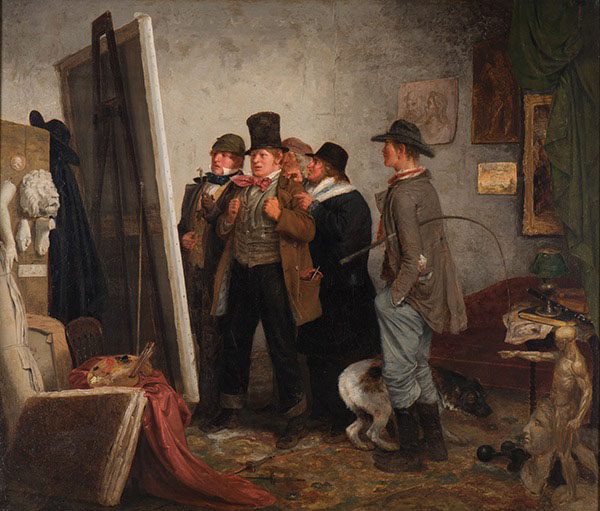
According to the artist’s son, German-American painter Johannes Oertel (1823-1909), created this work as a satirical response to the “country lads who would very often intrude to see what was going on in the paint shop.”
What do you think these people are looking at?
10 am: Take a photo of an interior scene of what you think the people are looking at!
2 pm: Take a photo of an exterior scene of what you think the people are looking at!
4 pm: Take a photo of yourself or someone else and share it with us!
Which activity was your favorite? Comment and share your photos on Facebook, Instagram and Twitter, and tag a friend you want to challenge!
Use the #’s #MuseumfromHome #ShelburneMuseumFromHome #ShelburneMuseum #TenTwoFourBreak #TenTwoFourBreakChallenge

Although she may have flown through the air with the greatest of ease, Lola, the daring young woman on the flying trapeze, experienced extreme physical discomfort performing the iron jaw act (shown in the central foreground). Suspending the full weight of another aerialist by a leather strap clenched between her teeth required great neck and mouth strength.
Trapeze artists are one of the amazing acts circuses have at their shows! They fly and perform stunts only professionals can do! Today we are going to encourage you to try out some other acts at the circus.
10 am: Grab 2-3 small, light objects and try to juggle!
2 pm: Grab an adult’s shoes and try to dance and move like a clown!
4 pm: Use tape or chalk outside to create a straight line on the ground, or imagine a straight line. Try to walk across the line with one foot in front of the other like a tightrope walker!
Which activity was your favorite? Comment on Facebook, Instagram and Twitter, and tag a friend you want to challenge!
Use the #’s #MuseumfromHome #ShelburneMuseumFromHome #ShelburneMuseum #TenTwoFourBreak #TenTwoFourBreakChallenge

This ram weathervane was used on a woolen mill along the Androscoggin River in Livermore Falls, Maine. It may be an accurate depiction of the Dorset breed of sheep, in which both the ram and the ewe grow horns.
Did you know people who predict the weather are called meteorologists? Meteorologists use many tools to measure the weather including what is pictured here called a weathervane. The weathervane helps meteorologists determine what direction the wind is traveling, which can help them understand how the weather will move over time. Today, we are going to become meteorologists and observe the wind direction during the day!
10 am: Go outside and check the direction the wind is traveling! Use feeling to do this. (What direction does your hair blow in? Can you feel a chill on your face?)
2 pm: Go outside and check the direction again!
4 pm: Go outside and find out what direction the wind is traveling again! Did it change?
Comment on Facebook, Instagram and Twitter what direction the wind was traveling for you today!
Use the #’s #MuseumfromHome #ShelburneMuseumFromHome #ShelburneMuseum #TenTwoFourBreak #TenTwoFourBreakChallenge
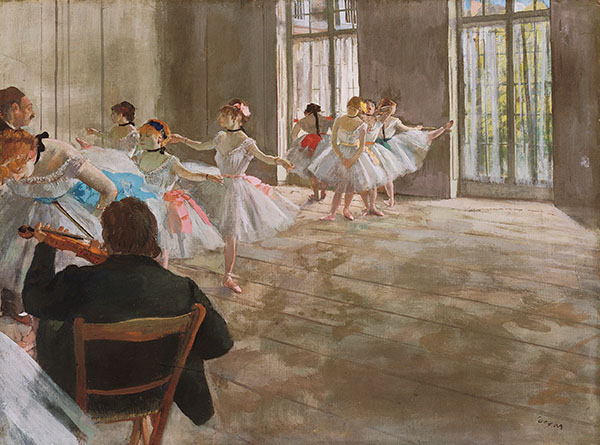
During the 19th century in Paris, France, extravagant musical and theatrical spectacles known as “grand operas” entertained the public. Artist Edgar Degas (French, 1834-1917), celebrated for his pastel drawings and oil paintings of these performers, captured them during performances and rehearsals at unexpected frames and angles, such as the stage wings, reflected in practice-room mirrors, and cast in the glow of stage lights. This painting, Repetition au Foyer, Degas captures their fleeting movements and forms, bathing them in natural light, and incorporating a strong, diagonal composition.
Doing ballet is a great way to show determination, perseverance, and expression! But, it is also a very challenging activity. Try to do just three different ballet moves and take pictures of yourself doing them!
10 am: Plié (Put your heels together, toes apart, bend your knees at a 45-degree angle, and stretch your arms out to the sides.)
2 pm: Relevé (Put your feet together, get on your tiptoes, and raise your arms above your head.)
4 pm: Sauté (Spread your feet, get on your tiptoes, let your arms hang at your sides, then jump straight up!)
Tag a friend you’d like to see do these moves on Facebook, Instagram and Twitter!
Use the #’s #MuseumfromHome #ShelburneMuseum #TenTwoFourBreak #TenTwoFourBreakChallenge
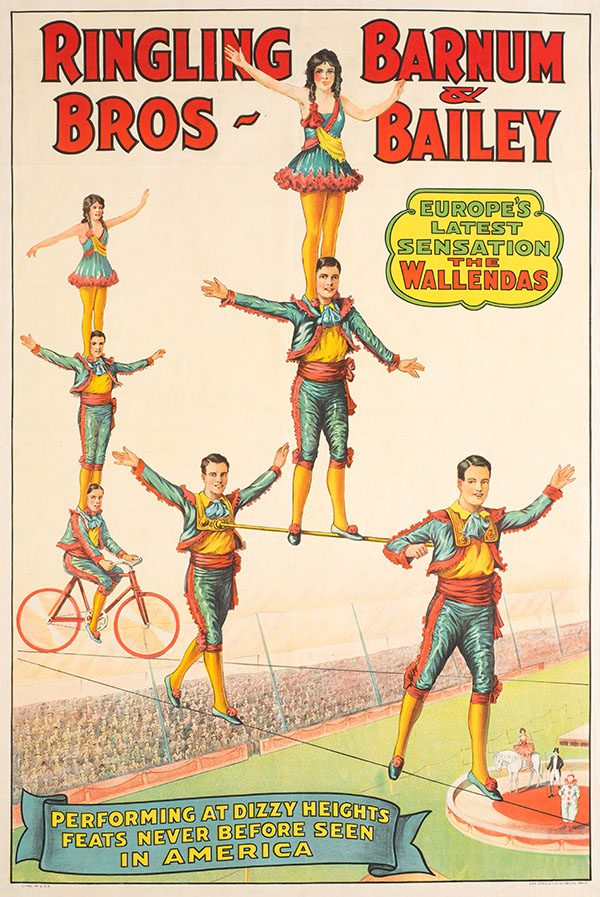
Billed as both the “Flying” and “Great,” the Wallendas are considered circus royalty producing multiple generations of performers. The Wallendas were known for their thrilling and death-defying acts, performed high above the circus ring without the safety of a net.
These Wallendas are professionals, but they had to start somewhere! Pretend you are training to become an acrobat with 3 exercises these athletes do to get ready. (Please find an area with lots of space for these activities.)
10 am Cardio: Try 20 jumping jacks and 10 mountain climbers.
2 pm: Strength: Try 20 side leg raises and 10 pushups.
4 pm Balance: Try to balance on one foot. (Try both sides!)
Share how long you were able to balance on one foot on Facebook, Instagram and Twitter!
Use the #’s #MuseumfromHome #ShelburneMuseumFromHome #ShelburneMuseum #TenTwoFourBreak #TenTwoFourBreakChallenge
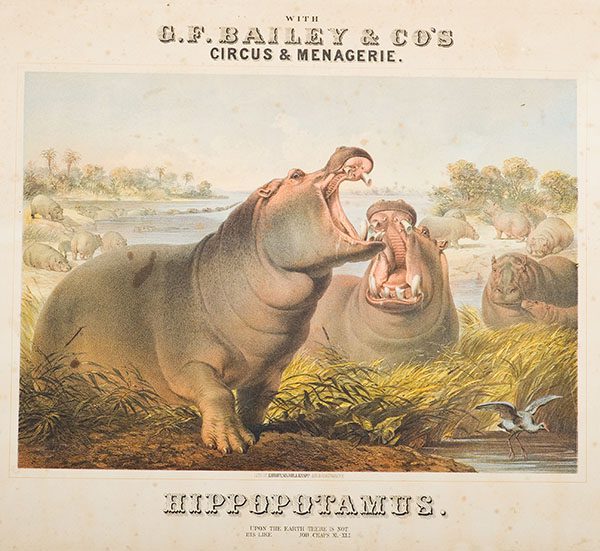
Printed at a time when circuses were considered “immoral” and many states, including Vermont, taxed them to the point of prohibition, this lithograph attempted to persuade audiences that G.F. Bailey & Co.’s Circus and Menagerie was a wholesome and spiritually up-lifting form of entertainment. It did so by identifying the hippopotamus as the behemoth mentioned in the Book of Job that “eatheth grass as an ox…moves his tail like a cedar…and drinketh up a river.”
Did you know hippos, lions, and elephants have one of the loudest roars among many types of animals? Let’s try to beat the volume of their roars today!
10 am: Go outside and roar like a hippo as loud as you can!
2 pm: Go outside and roar like a lion as loud as you can!
4 pm: Go outside and roar like an elephant as loud as you can!
Share this with your friends and send us your roar videos on Facebook, Instagram and Twitter!
Use the #’s #MuseumfromHome #ShelburneMuseum #ShelburneMuseumFromHome #TenTwoFourBreak #TenTwoFourBreakChallenge

Beginning in 1899, Monet spent three successive winters in London. Residing at the Savoy Hotel, the artist spent afternoons painting the contours of Charing Cross Bridge. Monet especially liked to paint atmospheric effects, and remarked in 1901 “The fog in London assumes all sorts of colors; there are black, brown, yellow, green, purple fogs.”
Go outside and look out far into the distance. Carefully look at the colors and how they seem to become paler and have less detail. Write down your observations or take a photo. What colors did you see?
Repeat the exercise at 2 pm and 4 pm. Do you see any changes in color? How does the position of the sun affect your observations?
Share your findings with us on Facebook, Instagram and Twitter.
Use the #’s #MuseumfromHome #ShelburneMuseumFromHome #ShelburneMuseum #TenTwoFourBreak #TenTwoFourBreakChallenge